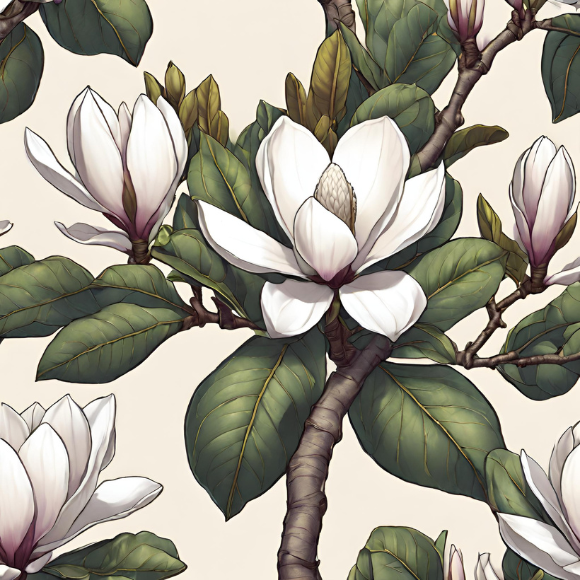
Overview
Kobus Magnolia, scientifically known as Magnolia kobus, is a graceful deciduous tree celebrated for its early Spring display of star-shaped flowers and elegant form. Native to East Asia, this magnolia species has become a cherished addition to gardens worldwide. This plant profile offers insights into the soil, sun, and watering requirements, along with the recommended hardiness zones for cultivating the Kobus Magnolia.
Description
Flowers: Kobus Magnolia is renowned for its fragrant, white, or slightly pink, star-shaped flowers that appear in profusion before the emergence of leaves in early Spring. The blossoms create a stunning contrast against the tree’s bare branches.
Foliage: The leaves of Kobus Magnolia are large, elliptical, and bright green. The foliage provides an attractive backdrop to the early Spring flowers, and it turns golden-yellow in the Fall, extending the tree’s seasonal appeal.
Size: Depending on the specific cultivar and growing conditions, Kobus Magnolia can reach heights of 20 to 30 feet with a similar spread. Its moderate size makes it suitable for various garden settings, including smaller landscapes.
Soil Requirements: Kobus Magnolia thrives in well-drained, slightly acidic to neutral soil. The ideal pH range is between 6.0 and 7.0. While it can adapt to different soil types, including loam and clay, ensuring good drainage is essential. Amending the soil with organic matter, such as compost, can enhance fertility and moisture retention, creating an optimal growing environment for Kobus Magnolia.
Sun Requirements: This magnolia variety performs best in full to partial sunlight. Providing Kobus Magnolia with at least four to six hours of direct sunlight each day encourages healthy growth, abundant flowering, and the development of well-formed foliage. While it can tolerate partial shade, exposure to sunlight is crucial for the tree’s overall vitality and the production of profuse blossoms.
Watering Needs: Kobus Magnolias benefit from consistent and moderate watering. While they can tolerate brief periods of drought once established, regular watering during dry spells, especially in the growing season, promotes healthy growth and flowering. It’s important to ensure that the soil remains evenly moist but not waterlogged, as overly wet conditions can lead to root rot.
Hardiness Zones: Kobus Magnolias are well-suited for cultivation in USDA hardiness zones 5 to 8. This range encompasses a variety of climates, from the colder Winters of zone 5 to the milder temperatures of zone 8. In these zones, Kobus Magnolias exhibit optimal growth and resilience, adapting well to the diverse environmental conditions found in different regions.
Zone 5: In colder regions within its hardiness range, Kobus Magnolias may benefit from protection during severe Winters, such as applying a layer of mulch around the base to insulate the roots.
Zones 6-8: Kobus Magnolias thrive in these zones, provided they receive the appropriate soil conditions, sunlight, and watering practices.
Maintenance
Pruning: Kobus Magnolias generally require minimal pruning. Remove any dead or damaged branches in late Winter or early Spring to encourage a tidy and well-shaped appearance. Avoid heavy pruning, as this can reduce the following year’s flower production.
Fertilization: Mature Kobus Magnolias typically do not require extensive fertilization. However, applying a balanced, slow-release fertilizer in early Spring can provide a nutrient boost for healthy growth and flowering.
Mulching: Applying a layer of organic mulch around the base helps conserve soil moisture, suppress weeds, and regulate soil temperature, contributing to the overall well-being of Kobus Magnolias.
The Kobus Magnolia, with its fragrant flowers and attractive foliage, is a versatile and enchanting addition to gardens of various sizes. By understanding and meeting its specific soil, sun, and watering requirements, gardeners can cultivate a thriving Kobus Magnolia that enhances the beauty of the landscape and brings early Spring blossoms to the garden.


 Previous
Previous

